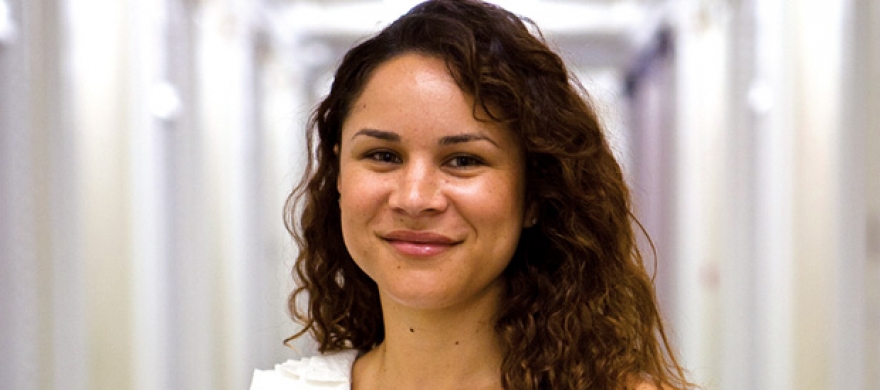A Great Education
As an education policy intern at the White House, School of Public Policy student Hattie Arrington begins a journey of creating change in our schools.
As an education policy intern at the White House, School of Public Policy student Hattie Arrington begins a journey of creating change in our schools.
A college freshman is touring downtown Los Angeles with a group of her peers. They visit Skid Row, the infamous city stretch that contains thousands of homeless persons. One stands out to her among the crowd: a baby crawling on the ground, watched by parents with nowhere to house their child. She is heartbroken for this family.
“I asked myself why and how does this happen in America? The word ‘education' popped into my head,” remembers School of Public Policy graduate student Hattie Arrington. “I decided that day that the only way to give these kids a chance was to give them a quality education. I became devoted to making quality education accessible to homeless and low-income kids.”
Just a few years later and Arrington has taken that devotion all the way to the White House, where she is one of just four graduate interns working for U.S. secretary of education Arne Duncan. After that life-changing Skid Row experience, she declared her major at the University of California, Los Angeles in urban learning, with a minor in elementary subject matter, and decided to achieve her goals not in the classroom but through education policy and legislation. Even as she completes her postgraduate degree at Pepperdine, she has begun to make her mark in Washington, D.C., contributing to prestigious government initiatives such as the first-ever White House Conference on Bullying Prevention.
Arrington helped plan the March 10 conference, identifying participants for the conversation about an issue that has made international headlines following a number of bullying-related teen suicides. In his opening remarks to the attendees, President Obama said the goal of the conference was to “dispel the myth that bullying is just a harmless rite of passage”—an assertion that Arrington wholeheartedly supports.
“It’s so important to create policies that protect students’ rights and to make schools a safe environment for all students, so that they can learn free of the fear of being bullied,” she says, adding that she also had the opportunity to attend meetings with Secretary Duncan for organizations that work with local communities to combat bullying. The conference was the most high-profile example of what she plans to achieve through her career choices: raising awareness of educational issues to create change on the ground.
“We wanted to ensure that everyone left empowered to go back to their communities to help prevent bullying. We were also able to bring school districts and educators together to think about solutions to the bullying problems at their schools. School districts, families, and communities—they should all work to protect their students.”
Without knowing the exact solutions right now to problems with such deep roots, Arrington does know that attempting to find solutions has motivated her to excel at her own schooling in order to reach the White House. The Department of Education is responsible for making financial decisions for education in the country, as well as studying educational initiatives and highlighting key educational issues.
The selection process is rigorously competitive for the five-month program, and since working with Secretary Duncan from January to May of this year, she has expanded her own repertoire of policy expertise and fired up her optimism and desire for change even more.
“I have had an overwhelmingly positive experience as an intern, having learned a lot from both my peers and my superiors,” she comments, adding that she considers internships during the second year of graduate studies to be the ideal time, due to the depth of understanding already achieved from the first year of policy study. “It’s an invaluable experience.”
Now that she has completed the White House internship program and is finishing her master’s work, she hopes to go on to law school in order to make a difference on the legislative side of education policy. Before then, she plans to spend a bit more time with her family, who have barely seen her in recent, hectic months, as well as volunteering “with homeless shelters, since they are still close to my heart.”
With that, Arrington circles back to the very reason she decided to pursue education policy—the Skid Row baby—when she adds that the highlight of her five months in Washington, D.C. was being exposed to programs already in place to further educational options and access for children across the country. She moves forward charged up with the belief that there is still progress to be made, and that she is one idealist ready for the job.
“My ultimate goal is to ensure that every child in America has access to a great education. I’d like to see that every person has an opportunity to go to school, graduate, go on to college, and be whatever it is they are passionate about.”
Hattie Arrington is photographed in the Eisenhower Executive Office Building in Washington, D.C., May 24, 2011. Credit: White House
